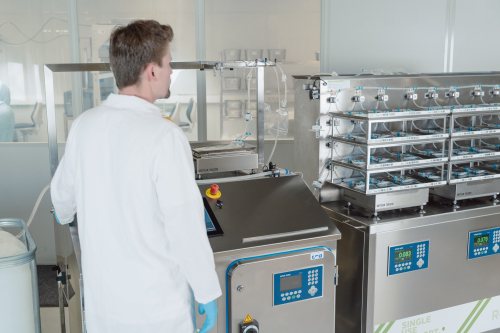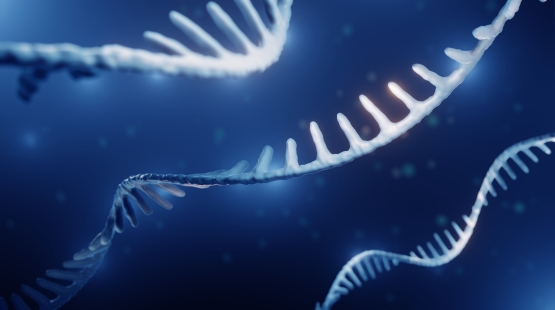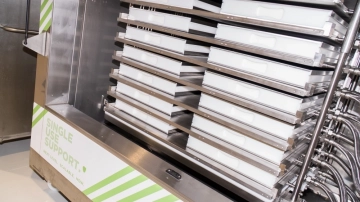RNase: Ribonuclease Simply Explained
Table of contents
ShowDefinition of RNase
Ribonuclease, commonly referred to as RNase, is an enzyme that catalyzes the degradation of RNA into smaller components. It is a ubiquitous enzyme found in all organisms. Due to its widespread presence and stability, RNase contamination can lead to the degradation of RNA, thereby compromising the efficacy of RNA-based drugs. Biopharmaceutical manufacturers therefore consider RNases to be a potential risk in the production of RNA-based therapies. [1]
Types of RNase
RNase enzymes come in various forms, each with specific functions and characteristics:
- RNase A: A well-known enzyme derived from bovine pancreas, RNase A cleaves single-stranded RNA at pyrimidine residues, forming cyclic phosphates.
- RNase E: Found in bacteria, RNase E is involved in RNA processing and decay, crucial for RNA maturation and turnover.
- RNase G: Similar to RNase E, RNase G is involved in mRNA decay and processing in bacteria.
- RNase H: This enzyme specifically degrades the RNA strand of RNA-DNA hybrids, playing a crucial role in the replication of retroviruses.
- RNase L: Part of the antiviral defense mechanism, RNase L degrades viral and cellular RNA, inhibiting protein synthesis in infected cells.
- RNase P: This ribonucleoprotein enzyme processes precursor tRNA molecules by cleaving their 5' leader sequences.
- RNase PhyM: Derived from the fungus Physarum polycephalum, RNase PhyM cleaves RNA at pyrimidine residues in single-stranded regions.
- RNase U2: Secreted by fungi, RNase U2 cleaves RNA at purine residues, forming cyclic phosphates.
- RNase V: This enzyme is less characterized but is known to cleave RNA in a sequence-specific manner.
RNase and DNase – What is the Difference?
RNase and DNase are both nucleases but differ in their substrates; RNase degrades RNA while DNase degrades DNA. In biopharmaceutical manufacturing, RNase contamination is particularly concerning for RNA-based products, while DNase contamination affects DNA-based products. [1] DNase contamination is less of a concern because DNA-based processes are generally more robust against degradation since they are double-stranded. [2]
Development of RNase - What Happens at the Molecular Level?
RNase enzymes act like scissors that cut RNA molecules into smaller pieces. They do this by breaking specific links, called phosphodiester bonds, between the building blocks of RNA. During this cutting process, a temporary loop forms, which is then opened up to create a smaller piece of RNA.
This enzymatic activity is essential for RNA processing and turnover in biological systems but poses a risk in RNA-based drug production due to potential degradation of the therapeutic RNA.[2]

Is RNase a Threat in mRNA Manufacturing?
Yes, RNase is a threat in mRNA manufacturing. Its ability to degrade mRNA can severely impact the quality and efficacy of mRNA-based therapies and vaccines. As mRNA technology becomes more prevalent, especially in personalized medicine, controlling RNase contamination is critical.[2]
To prevent RNase contamination on a small scale, diethyl pyrocarbonate (DEPC) treatment is commonly used. DEPC inactivates RNase by modifying histidine residues, but care must be taken as DEPC can leave residues that interfere with subsequent reactions. DEPC is also incompatible with certain buffers, necessitating alternative methods for RNase inactivation in some cases.[1]
Since mRNA manufacturing is still new in large scales, there are uncertainties of the influence of RNases on the mRNA in commercial manufacturing. Comparative tests would help to understand the effects of RNases on large volumes.
In conclusion, while RNase is an essential enzyme in biological systems, its presence in biopharmaceutical manufacturing poses challenges that require careful management to ensure the integrity of RNA-based products.

Download App Note
The Chilled Future of RNA Therapeutics Filling & Freezing Applications
More about mRNA manufacturing
References
- BioProcess International: The Messenger — Introduction to mRNA Manufacturing, 2023. Available at: Introduction to mRNA Manufacturing - BioProcess International (bioprocessintl.com)
- Blom, H.: Reducing the risk of RNAse contamination in mRNA production. 2022. Available at: Reducing the risk of RNAse contamination in mRNA production | Cytiva (cytivalifesciences.com)










